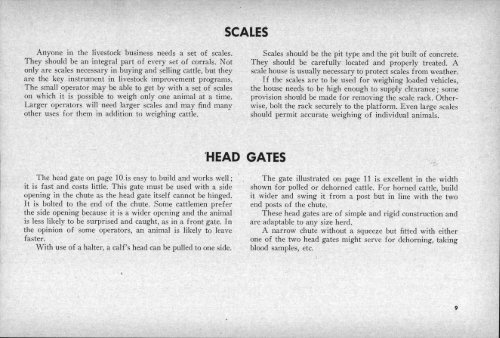Create successful ePaper yourself
Turn your PDF publications into a flip-book with our unique Google optimized e-Paper software.
Anyone in the livestock business needs a set of scales.<br />
They should be an integral part of every set of corrals. Not<br />
only are scales necessary in buying and selling cattle, but they<br />
are the key instrument in livestock improvement programs.<br />
The small operator may be able to get by with a set of scales<br />
on which it is possible to weigh only one animal at a time.<br />
Larger operators will need larger scales and may find many<br />
other uses for them in addition to weighing cattle.<br />
The head gate on page 10 is easy to build and works well ;<br />
it is fast and costs little. This gate must be used with a side<br />
opening in the chute as the head gate itself cannot be hinged.<br />
It is bolted to the end of the chute. Some cattlemen prefer<br />
the side opening because it is a wider opening and the animal<br />
is less likely to be surprised and caught, as in a front gate. In<br />
the opinion of some operators, an animal is likely to leave<br />
faster.<br />
With use of a halter, a calf's head can be pulled to one side.<br />
SCALES<br />
'HEAD GATES<br />
Scales should be the pit type and the pit built of concrete.<br />
They should be carefully located and properly treated. A<br />
scale house is usually necessary to protect scales from weather.<br />
If the scales are to be used for weighing loaded vehicles,<br />
the house needs to be high enough to supply clearance; some<br />
provision should be made for removing the scale rack. Otherwise,<br />
bolt the rack securely to the platform. Even large scales<br />
should permit accurate weighing of individual animals.<br />
The gate illustrated on page 11 is excellent in the width<br />
shown for polled or dehorned cattle. For horned cattle, build<br />
it wider and swing it from a post but in line with the two<br />
end posts of the chute.<br />
These head gates are of simple and rigid construction and<br />
are adaptable to any size herd.<br />
A narrow chute without a squeeze but fitted with either<br />
one of the two head gates might serve for dehorning, taking<br />
blood samples, etc.<br />
9
















